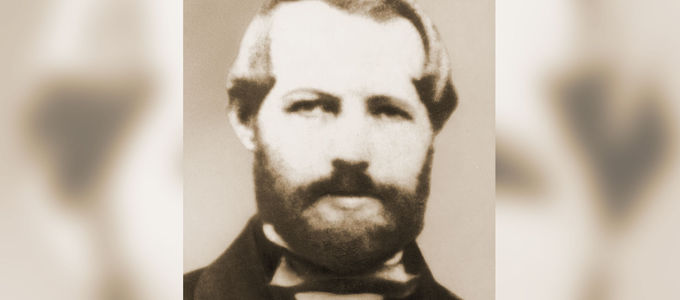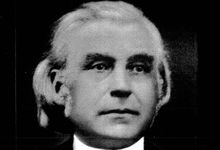A pioneer in the new tradition
Silesia, with its beautiful landscape on both sides of the river Oder still existed in those days. This region, together with the city of Berlin, constituted the working area of the fourth entry in the register of the Apostles of the New Apostolic Church: Johann August Ludwig Bösecke. It was on this day 200 years ago that he was born.

His place of birth was Schwedt on the Oder in the district of Uckermark-Brandenburg, Germany. It was there that Johann August Ludwig Bösecke—such was his full baptised name—first saw the light of day on 14 April 1821. As a young man, he went to Berlin and worked there as an independent shoemaker and porcelain merchant. In accordance with the longstanding tradition of his fathers, he regularly went to church. He soon became acquainted with the Catholic Apostolic Church, and ultimately joined its ranks. By the end of the year 1862, however, the tensions there had become quite high, especially with regard to the question of the continuation of the Apostle ministry. In the year 1863, the new Apostles separated from the old. Two apostolic denominations came into being and began to develop in parallel to one another. Ludwig Bösecke, then in his mid forties, made his choice for the new direction of the Church and also made the decision to take on responsibility there.
From Berlin to Hamburg and back again
At the time, there was no New Apostolic congregation in Berlin, only in Hamburg. The latter was led by Apostle Carl Wilhelm Louis Preuss. Again and again, Bösecke was compelled to go to Hamburg if he wanted to attend a divine service. It was there on 30 October 1864 that a prophetic call went forth. It was customary in those days for prophets to raise their voices and express important information to the assembled congregation in the name of God. It was no different on this occasion: the well-known and very influential prophet, Heinrich Geyer, called four men to the Apostle ministry that day, namely Ludwig Bösecke, Johann Christoph Hohl, Heinrich Ferdinand Hoppe, and Peter Wilhelm Louis Stechmann. In the same breath, each was assigned his own working area. Bösecke was to go to Silesia, Bohemia, Poland, and the Lausitz region in order to establish new congregations there.
But the disciple remained in the vicinity of his teacher for just a little longer: at first Bösecke commuted back and forth between Berlin and Hamburg, patiently becoming proficient in the duties of an Apostle by learning from his mentor, Preuss. In the venerable imperial capital of Berlin, he soon succeeded in establishing a small congregation. The first divine services took place in a shoemaker’s workshop, and were attended by as many as twenty people.
From Berlin to Breslau and back again
Then in 1872, he made his way to the province of Silesia, as required by his apostolic mandate. Silesia itself was quite different from the cosmopolitan city of Berlin. It was rural, idyllic, and Catholic. A difficult missionary effort awaited him there. Some years later, his son Conrad related the following about these early years: “In order to finance his journeys and make it possible for him to make a start in this new region, we gave up our basement apartment [in Berlin], where father had worked as an independent shoemaker, and even sold some of our household effects. Mother and I moved in with some brothers and sisters in faith, who took us in and often fed us for free since we no longer had any funds to our name. I was no longer able to attend school because we no longer had enough money for that. Although we had not possessed great wealth beforehand either, it was at this point that a time of bitter need began for us.”
The Silesian Apostle now had two equally important tasks ahead of him: the first was to make a completely new start for himself and his family, and the other was to pursue the missionary work of his Church, with the aim of establishing new congregations. He managed to succeed with the first step that very same year: the Apostle was able to bring his family to join him. They found a new home for themselves in Schönau (present-day Świerzawa, Poland). There the Apostle rented a little hall in a guesthouse for regular divine services. The beginnings were difficult, but before long, a small congregation was assembled. One of its members was another shoemaker by the name of Ernst Traugott Hallmann, who would come to travel extensively as an Apostle some 25 years later. He had just turned 19 at the time, and had become quite captivated by the divine services.
There was yet another pioneer who grew up and developed in the little congregation of Schönau, namely Ernst Obst, who would later be called as Apostle for Silesia, as successor to the Apostle Bösecke following his death.
From Breslau to Berlin and back again
In 1878 Apostle Bösecke went back to Berlin again. The congregation there had been almost completely scattered, and only ten members had remained. Bösecke called on his friend and Priest Ernst Traugott Hallmann to leave Silesia and come to Berlin. He was to lead the Berlin congregation and give it some new momentum. Bösecke himself became increasingly ill, and finally returned to Silesia in 1883. He and his family were now living with his son Conrad in Breslau. Excursions to Berlin were no longer possible, due to his poor health. For this reason, he asked Apostle Friedrich Krebs to take over responsibility for the congregation of Berlin in 1884.
As it turned out, the Apostle’s increased focus on Silesia was also quite urgently needed: during his absence, the prophet Geyer had established his own church and endeavoured to win new members for himself wherever he could. And the latter had been quite successful in this effort, as only a few members had stayed with Apostle Bösecke. How bitter it must have been for him to lose so many of the congregation’s members so near to the end of his life!
By the middle of the 1880s, the Apostle was no longer able to undertake any trips, and had to restrict his activity to Breslau. It was there that he passed away on 2 August 1886 at the age of 65. His contribution as a pioneer to the establishment of the New Apostolic Church in Berlin and Silesia will never be forgotten.










